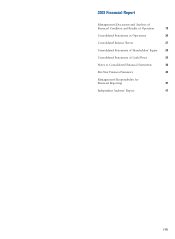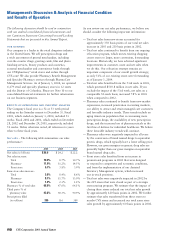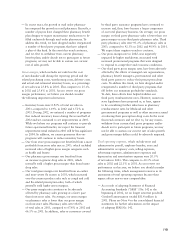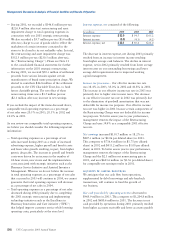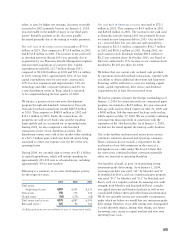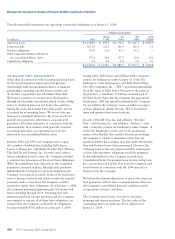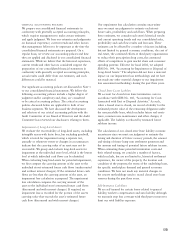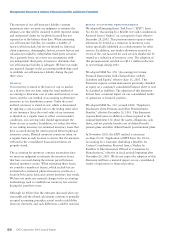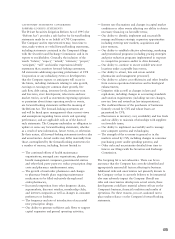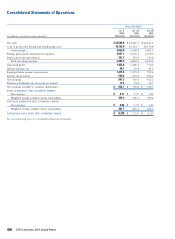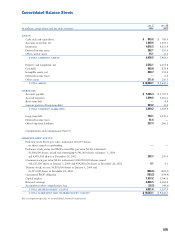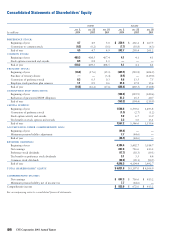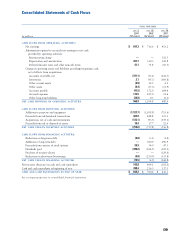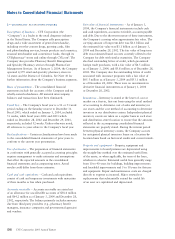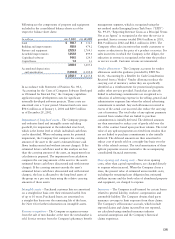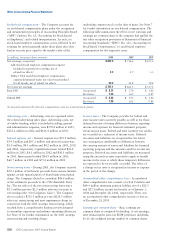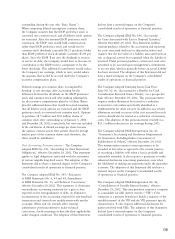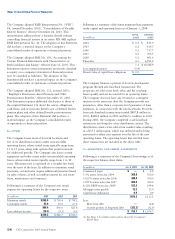CVS 2003 Annual Report Download - page 26
Download and view the complete annual report
Please find page 26 of the 2003 CVS annual report below. You can navigate through the pages in the report by either clicking on the pages listed below, or by using the keyword search tool below to find specific information within the annual report.Management’s Discussion & Analysis of Financial Condition and Results of Operation
(24) CVS Corporation 2003 Annual Report
The estimate of our self-insurance liability contains
uncertainty since we must use judgment to estimate the
ultimate cost that will be incurred to settle reported claims
and unreported claims for incidents incurred but not
reported as of the balance sheet date. When estimating
our self-insurance liability, we consider a number of
factors, which include, but are not limited to, historical
claim experience, demographic factors, severity factors and
valuations provided by independent third-party actuaries.
On a quarterly basis, we review our assumptions with
our independent third party actuaries to determine that
our self-insurance liability is adequate. We have not made
any material changes in the accounting methodology used
to establish our self-insurance liability during the past
three years.
Inventory
Our inventory is stated at the lower of cost or market
on a first-in, first-out basis using the retail method of
accounting to determine cost of sales and inventory in our
stores, and the cost method of accounting to determine
inventory in our distribution centers. Under the retail
method, inventory is stated at cost, which is determined
by applying a cost-to-retail ratio to the ending retail value
of our inventory. Since the retail value of our inventory
is adjusted on a regular basis to reflect current market
conditions, our carrying value should approximate the
lower of cost or market. In addition, we reduce the value
of our ending inventory for estimated inventory losses that
have occurred during the interim period between physical
inventory counts. Physical inventory counts are taken on
a regular basis in each location to ensure that the amounts
reflected in the consolidated financial statements are
properly stated.
The accounting for inventory contains uncertainty since
we must use judgment to estimate the inventory losses
that have occurred during the interim period between
physical inventory counts. When estimating these losses,
we consider a number of factors, which include but are
not limited to, historical physical inventory results on a
location-by-location basis and current inventory loss trends.
We have not made any material changes in the accounting
methodology used to establish our inventory loss reserves
during the past three years.
Although we believe that the estimates discussed above are
reasonable and the related calculations conform to generally
accepted accounting principles, actual results could differ
from our estimates, and such differences could be material.
RECENT ACCOUNTING PRONOUNCEMENTS
We adopted Emerging Issues Task Force (“EITF”) Issue
No. 02-16, “Accounting by a Reseller for Cash Consideration
Received from a Vendor,” on a prospective basis effective
December 29, 2002. This pronouncement requires vendor
allowances be treated as a reduction in inventory costs
unless specifically identified as a reimbursement for other
services. In addition, any vendor allowances received in
excess of the cost incurred for such services should also be
treated as a reduction of inventory costs. The adoption of
this pronouncement resulted in a $13.3 million reduction
in net earnings during 2003.
We adopted SFAS No. 150, “Accounting for Certain
Financial Instruments with Characteristics of Both
Liabilities and Equity,” effective June 15, 2003. This
Statement requires certain instruments previously classified
as equity on a company’s consolidated balance sheet to now
be classified as liabilities. The adoption of this Statement
did not have a material impact on our consolidated results
of operations or financial position.
We adopted SFAS No. 132, (revised 2003) “Employer’s
Disclosures about Pensions and Other Postretirement
Benefits,” effective December 15, 2003. This Statement
requires disclosures in addition to those required in the
original Statement 132 about the assets, obligations, cash
flows, and net periodic benefit cost of defined benefit
pension plans and other defined benefit postretirement plans.
In November 2003, the EITF reached a consensus
on Issue 03-10, “Application of EITF Issue No. 02-16,
Accounting by a Customer (Including a Reseller) for
Certain Consideration Received from a Vendor, by
Resellers to Sales Incentives Offered to Consumers by
Manufacturers,” effective in fiscal periods beginning after
November 26, 2003. We do not expect the adoption of this
Statement will have a material impact on our consolidated
results of operations or financial position.





